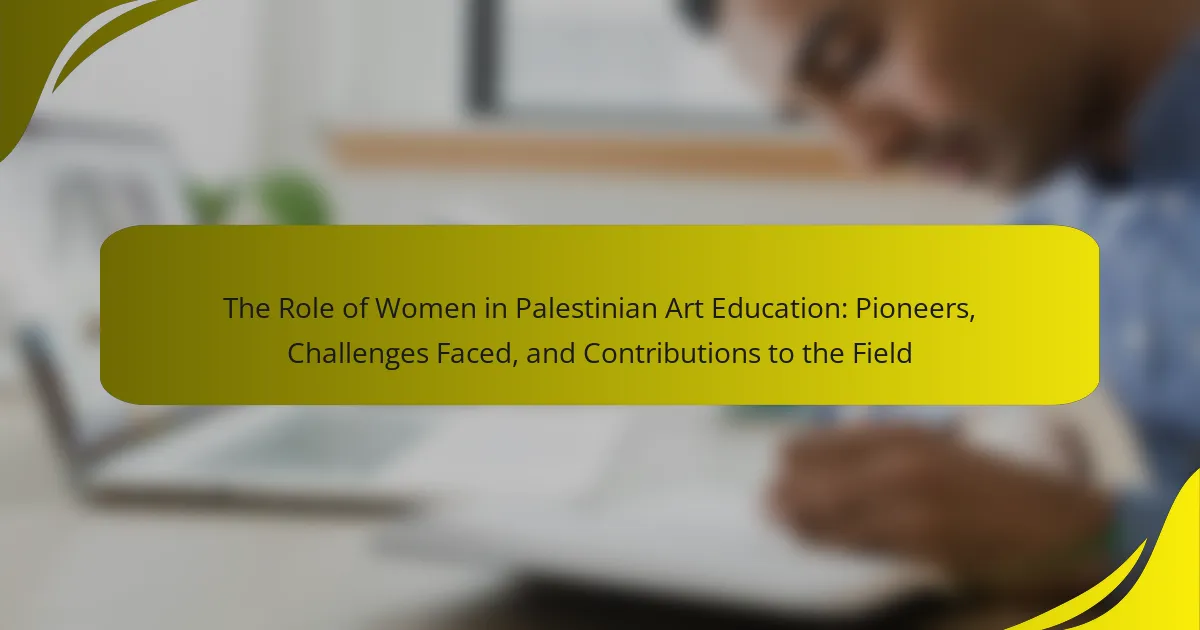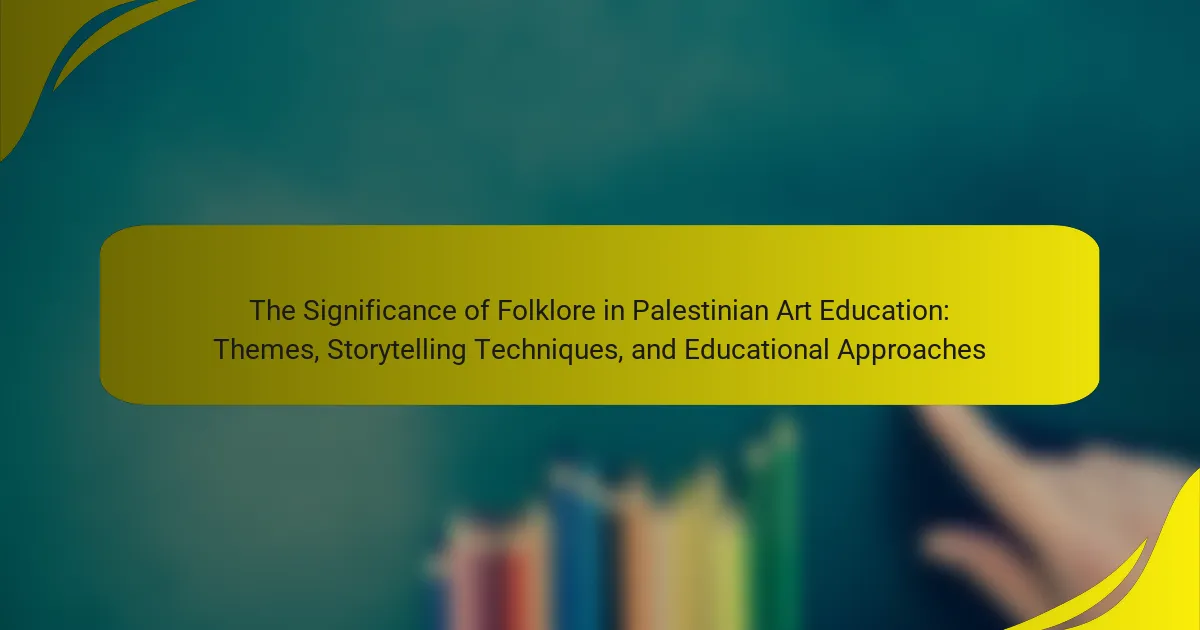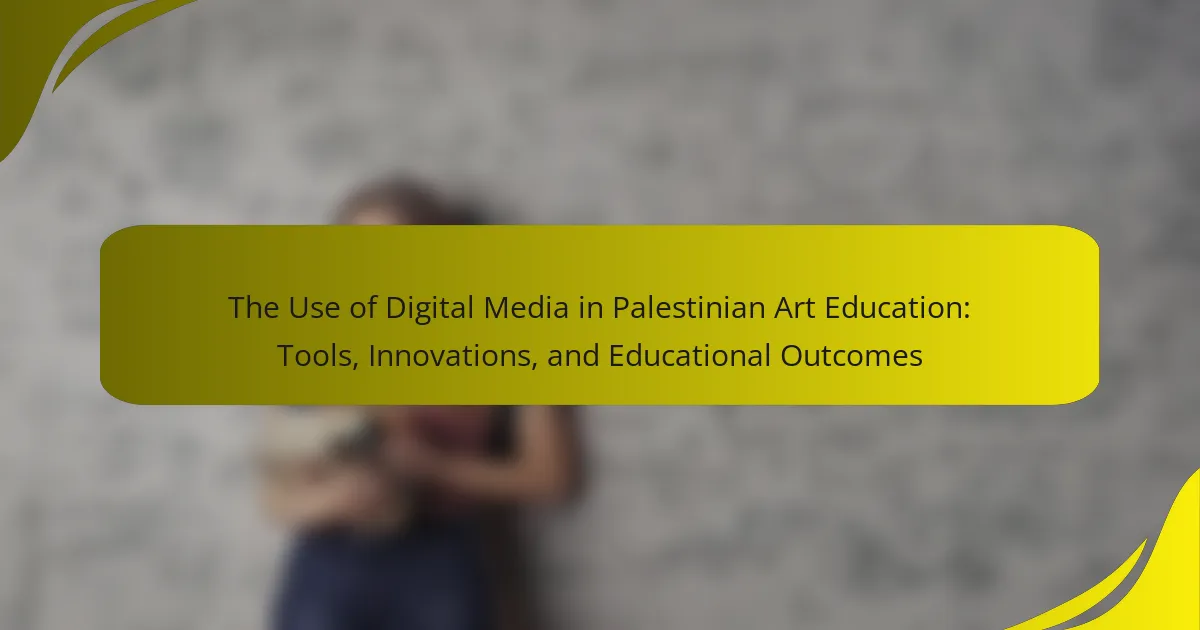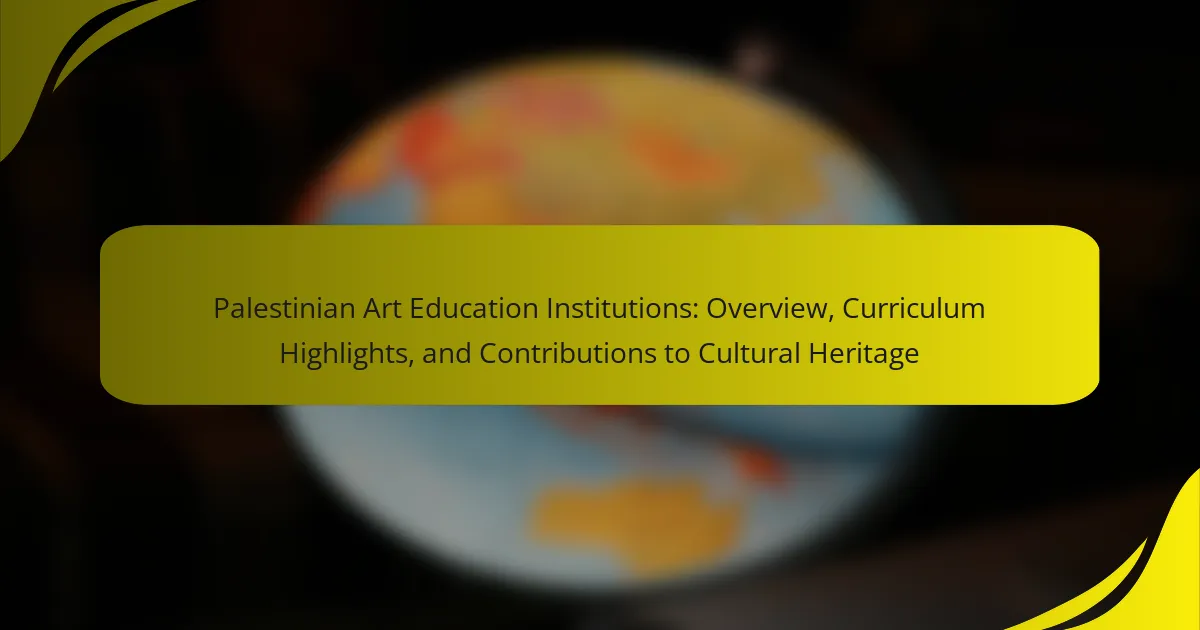The article examines the impact of globalization on Palestinian art education, highlighting both opportunities and challenges. It discusses how globalization facilitates access to international artistic trends, enhances curricula, and fosters collaborations with global artists and educators. However, it also addresses significant obstacles, including political restrictions, limited resources, and cultural appropriation that affect the authenticity of Palestinian artistic expression. Future directions for Palestinian art education are explored, emphasizing the importance of international partnerships and digital integration to enhance visibility and accessibility for Palestinian artists. The article underscores the potential for innovative practices through cultural exchange and collaboration in a globalized context.
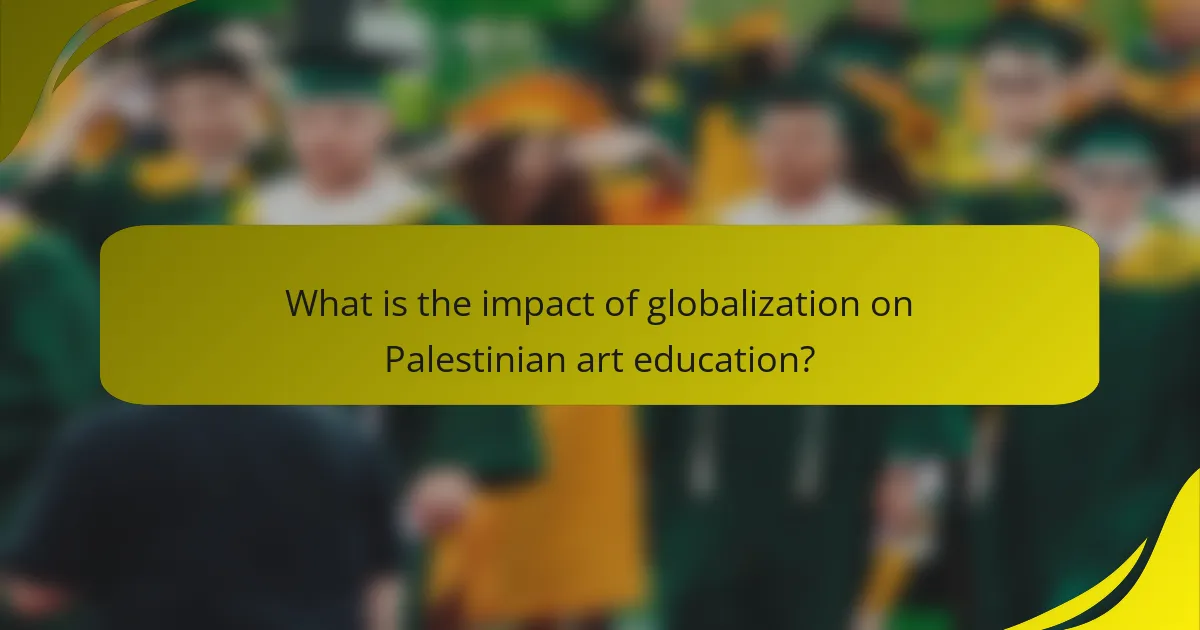
What is the impact of globalization on Palestinian art education?
Globalization has significantly influenced Palestinian art education. It has facilitated access to international artistic trends and practices. This exposure enhances the curriculum and teaching methodologies in Palestinian institutions. Collaborations with global artists and educators provide valuable insights and resources. Additionally, globalization promotes cultural exchange, enriching local art narratives. However, challenges such as political restrictions can hinder these benefits. Overall, globalization shapes both the opportunities and limitations within Palestinian art education.
How has globalization influenced the curriculum in Palestinian art education?
Globalization has significantly influenced the curriculum in Palestinian art education by introducing diverse artistic practices and methodologies. This influence includes the integration of international art movements into local educational frameworks. Palestinian art programs now incorporate global themes and issues, reflecting a broader cultural context. Collaborative projects with international artists have enriched the curriculum, providing students with exposure to various perspectives. Additionally, access to online resources and global art networks has expanded learning opportunities. The incorporation of contemporary global art trends has encouraged innovation among Palestinian artists. This shift helps students engage with both local and international art scenes, enhancing their artistic expression.
What specific changes have emerged in art teaching methodologies due to globalization?
Art teaching methodologies have evolved significantly due to globalization. Increased access to diverse artistic styles is one major change. Educators now incorporate global art forms into curricula. This exposure enriches students’ creative perspectives. Collaborative projects with international artists have become more common. Such collaborations enhance cultural exchange and understanding. Technology also plays a crucial role in these changes. Online platforms facilitate global art discussions and workshops. Research indicates that these methodologies foster innovation and adaptability in students. Overall, globalization has broadened the scope of art education, making it more inclusive and interconnected.
How do global art trends shape local Palestinian art education practices?
Global art trends influence local Palestinian art education practices by integrating contemporary techniques and concepts. These trends encourage the adoption of diverse artistic styles and mediums. Palestinian educators often incorporate global themes into their curricula to enhance relevance. Workshops with international artists further expose students to global practices. Collaboration with foreign institutions introduces new pedagogical methods. This exchange fosters a broader understanding of art’s role in society. Consequently, students gain skills that resonate on a global scale. The impact of these trends is evident in exhibitions showcasing a blend of local and international influences.
What are the key trends in Palestinian art education influenced by globalization?
Key trends in Palestinian art education influenced by globalization include increased access to international art resources and pedagogies. Globalization has facilitated partnerships with foreign institutions. These collaborations enhance curriculum development and teaching methodologies. Moreover, exposure to global art movements influences local artistic expressions. Digital platforms allow Palestinian artists to showcase their work internationally. This visibility fosters cultural exchange and dialogue. Additionally, the incorporation of diverse artistic practices enriches local art education. Overall, globalization shapes a more interconnected and dynamic art education landscape in Palestine.
Which contemporary art movements are being integrated into Palestinian education?
Contemporary art movements integrated into Palestinian education include conceptual art, street art, and performance art. Conceptual art focuses on ideas and concepts over traditional aesthetics. Street art serves as a form of social commentary and expression in urban settings. Performance art engages audiences through live experiences and often addresses political themes. These movements are incorporated through workshops, exhibitions, and collaborative projects with international artists. Evidence of this integration can be seen in programs at institutions such as the International Academy of Art Palestine. Collaborations with organizations like Artis and the A.M. Qattan Foundation further support this integration.
How are technological advancements affecting art education in Palestine?
Technological advancements are significantly enhancing art education in Palestine. Digital tools and platforms provide new avenues for creative expression. Access to online resources expands learning opportunities for students and educators. Virtual workshops and webinars connect Palestinian artists with global experts. Social media enables wider dissemination of Palestinian art. Technology facilitates collaboration across borders, fostering cultural exchange. These advancements contribute to a more dynamic and inclusive art education landscape in Palestine.
What role do collaborations play in enhancing Palestinian art education?
Collaborations play a crucial role in enhancing Palestinian art education. They foster knowledge exchange between local and international artists and educators. Collaborations provide access to diverse artistic techniques and methodologies. They also facilitate workshops and exhibitions that broaden students’ perspectives. Collaborative projects often secure funding and resources for art programs. This support enables the development of infrastructure and materials for education. Additionally, partnerships can promote cultural dialogue and understanding through art. Engaging with global networks helps Palestinian artists gain visibility and recognition.
How do international partnerships impact the quality of art education in Palestine?
International partnerships enhance the quality of art education in Palestine by providing access to resources, expertise, and new methodologies. These collaborations often involve institutions from various countries that share knowledge and best practices. For instance, partnerships with European art schools have introduced innovative teaching techniques. This exposure helps Palestinian educators improve their curricula and teaching methods. Additionally, international partnerships facilitate exchange programs, allowing students to gain diverse perspectives. Funding from global organizations also supports art projects and initiatives in Palestinian institutions. Research indicates that such collaborations lead to improved student outcomes and greater artistic expression. Overall, international partnerships significantly elevate the standards of art education in Palestine.
What types of collaborative projects are most common in Palestinian art education?
Collaborative projects in Palestinian art education often include community art initiatives, artist residencies, and cross-cultural exchange programs. Community art initiatives involve local artists working with students to create public art installations. Artist residencies provide opportunities for artists to mentor students while developing their own projects. Cross-cultural exchange programs facilitate partnerships with international institutions, allowing for shared learning experiences. These projects aim to foster creativity and cultural dialogue. They also enhance the visibility of Palestinian art on global platforms. Through these collaborations, students gain valuable skills and insights into diverse artistic practices.
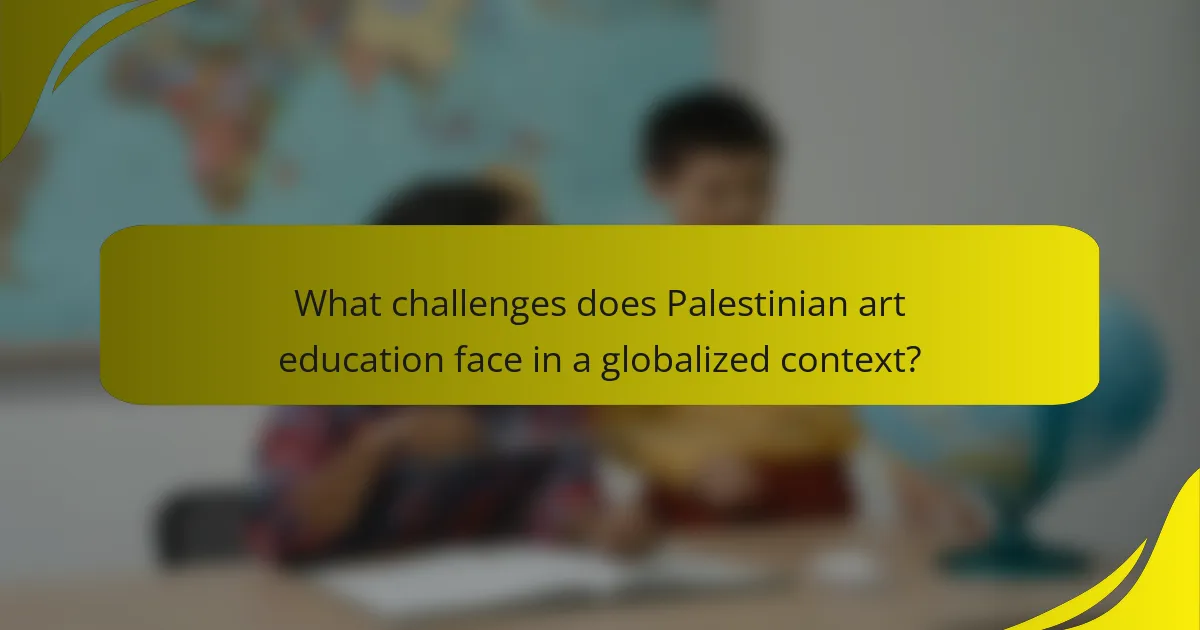
What challenges does Palestinian art education face in a globalized context?
Palestinian art education faces significant challenges in a globalized context. Limited access to resources hinders the development of art programs. Political instability restricts opportunities for collaboration with international institutions. Cultural appropriation often undermines the authenticity of Palestinian artistic expression. Economic constraints limit funding for art education initiatives. Additionally, a lack of exposure to global art trends affects the curriculum. These factors collectively impact the ability of Palestinian artists to engage with the global art community.
How does political instability affect art education in Palestine?
Political instability significantly hinders art education in Palestine. It restricts access to resources and safe learning environments. Schools often face closures due to conflict, limiting students’ opportunities to engage in art. Additionally, funding for art programs is frequently diverted to address immediate humanitarian needs. The psychological impact of ongoing violence affects both students and educators, stifling creativity and expression. Furthermore, political restrictions can limit exposure to diverse artistic influences. As a result, the overall quality and scope of art education suffer. This situation creates a challenging atmosphere for nurturing artistic talent in Palestine.
What are the barriers to accessing global art resources for Palestinian educators?
Palestinian educators face multiple barriers to accessing global art resources. These barriers include political restrictions that limit mobility and communication. The ongoing conflict in the region creates instability, impacting resource availability. Limited funding for educational institutions restricts access to international art programs. Additionally, language barriers hinder the ability to engage with global art communities. Internet access can be unreliable, affecting online resource availability. Furthermore, cultural differences may lead to a lack of relevance in global resources for local contexts. These factors collectively hinder the ability of Palestinian educators to fully utilize global art resources.
How do cultural perceptions influence the reception of global art education in Palestine?
Cultural perceptions significantly influence the reception of global art education in Palestine. Traditional values and local customs shape how art education is viewed. Many Palestinians prioritize cultural identity and heritage over global trends. This creates resistance to external influences perceived as undermining local traditions. Educational programs that align with cultural values receive more acceptance. Conversely, programs that disregard local context face skepticism. The historical context of occupation and resistance further complicates perceptions of foreign educational initiatives. Understanding these cultural dynamics is essential for effective art education in Palestine.
What are the implications of globalization for the future of Palestinian art education?
Globalization significantly impacts the future of Palestinian art education by increasing access to diverse artistic influences. It allows for collaboration with international artists and educators, enhancing curriculum development. Global networks can provide resources and funding for art programs. Furthermore, exposure to global art movements can foster innovation among Palestinian artists. However, globalization may also lead to cultural dilution, risking the authenticity of Palestinian art. Balancing global influences with local traditions is crucial for sustainable art education. The integration of technology in art education also reflects globalization, offering new platforms for expression. Ultimately, globalization presents both opportunities and challenges for Palestinian art education’s evolution.
How can Palestinian art educators adapt to ongoing global changes?
Palestinian art educators can adapt to ongoing global changes by integrating contemporary global art practices into their curricula. This includes exploring digital art and multimedia platforms, which have become essential in the global art scene. They can also foster collaborations with international artists and educators to exchange ideas and techniques. Engaging with global art movements allows them to contextualize their work within broader dialogues. Additionally, they can utilize social media to showcase Palestinian art to a global audience. This visibility can promote cultural exchange and understanding. By participating in international exhibitions, educators can broaden their networks and influence. These strategies help Palestinian art educators remain relevant in a rapidly evolving global landscape.
What strategies can be employed to preserve local artistic identity amidst globalization?
Promoting local artistic identity amidst globalization requires several strategies. First, fostering community engagement in the arts can help maintain cultural heritage. Local art workshops and festivals can encourage participation and appreciation of traditional art forms. Second, integrating local art history into educational curricula supports knowledge transmission. Schools can teach students about their artistic roots and significance. Third, supporting local artists through grants and exhibitions can enhance visibility. This can lead to a stronger market for local art. Fourth, collaboration with international artists can create cross-cultural exchanges. These exchanges can enrich local practices while maintaining distinct identities. Lastly, utilizing digital platforms to showcase local art can reach wider audiences. This can help preserve and promote local styles globally.
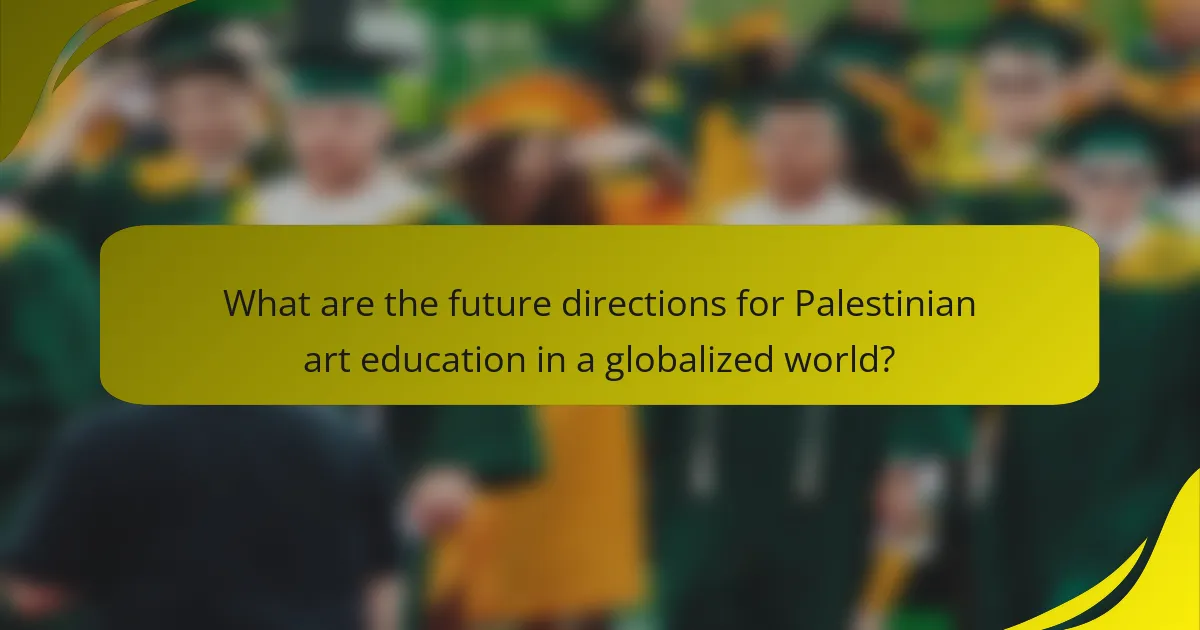
What are the future directions for Palestinian art education in a globalized world?
Future directions for Palestinian art education in a globalized world include increased international collaboration and digital integration. These approaches can enhance visibility and accessibility for Palestinian artists. Global partnerships with art institutions can provide resources and exposure. Digital platforms can facilitate remote learning and engagement with global audiences. Emphasizing cultural exchange will enrich the curriculum and broaden perspectives. Research indicates that such collaborations can lead to innovative practices in art education. For instance, programs like the International Art Education Network have successfully connected artists across borders. This trend aligns with the growing recognition of diverse artistic voices in the global art community.
How can Palestinian art education leverage globalization for growth?
Palestinian art education can leverage globalization for growth by integrating international art practices and fostering cross-cultural collaborations. Globalization allows access to diverse artistic influences and methodologies. This exposure can enhance the curriculum and teaching techniques in Palestinian art institutions. Collaborations with global artists and educators can provide mentorship opportunities for students. Online platforms enable Palestinian artists to showcase their work to a broader audience. This visibility can attract funding and support from international organizations. Additionally, partnerships with foreign art institutions can facilitate student exchanges and workshops. Such initiatives can enrich the educational experience and promote cultural dialogue.
What innovative practices can be adopted to enhance art education in Palestine?
Innovative practices to enhance art education in Palestine include integrating technology into the curriculum. Utilizing digital platforms can facilitate remote learning and collaboration. Virtual workshops can connect Palestinian artists with global experts. Community art projects can foster local engagement and cultural exchange. Incorporating interdisciplinary approaches can enrich the educational experience. For example, combining art with social studies can provide context and relevance. Establishing partnerships with international art institutions can provide resources and expertise. These practices can help address the unique challenges faced in Palestinian art education.
How can art educators in Palestine foster a global perspective while maintaining local relevance?
Art educators in Palestine can foster a global perspective while maintaining local relevance by integrating international art practices with local cultural themes. They should encourage students to explore global art movements and their historical contexts. This approach can be achieved through collaborative projects with international artists. Workshops and exchanges can provide exposure to diverse artistic methodologies. Additionally, incorporating local narratives into global themes can create meaningful connections. Art educators can also utilize technology to connect with global art communities. By doing so, they promote a dialogue between local and international art scenes. This dual focus enriches students’ understanding and appreciation of their own cultural identity.
What best practices can be implemented to improve Palestinian art education?
Implementing collaborative art programs can significantly improve Palestinian art education. These programs foster partnerships between local and international artists. They provide students with exposure to diverse artistic techniques and perspectives. Incorporating technology into art education enhances accessibility and engagement. Digital platforms can facilitate virtual workshops and exhibitions. Establishing community art centers promotes local talent and offers resources. These centers can host classes and provide mentorship opportunities. Curriculum development should include cultural heritage and contemporary issues. This approach connects students with their identity and current global trends. Engaging in art activism can empower students to express their views and inspire social change.
How can community involvement enhance the effectiveness of art education programs?
Community involvement enhances the effectiveness of art education programs by fostering collaboration and support. Engaged communities provide resources such as funding, materials, and venues. This support can lead to more diverse programming and increased accessibility for students. Additionally, community members can share local cultural knowledge, enriching the curriculum. Research shows that programs with strong community ties report higher student engagement and retention rates. For example, a study by the National Endowment for the Arts found that community-based arts initiatives improve educational outcomes. Thus, active community participation is crucial for the success of art education programs.
What role does mentorship play in the development of art educators in Palestine?
Mentorship plays a crucial role in the development of art educators in Palestine. It provides guidance and support to emerging educators. Experienced mentors share knowledge and teaching strategies. This exchange enhances pedagogical skills and artistic practices. Mentorship fosters a sense of community among educators. It encourages collaboration and innovation in art education. Research indicates that mentorship leads to improved teaching outcomes. For example, a study by the Palestinian Art Education Network highlights the positive impact of mentorship on teaching effectiveness.
The main entity of this article is Palestinian art education. The article examines the impact of globalization on Palestinian art education, highlighting how it facilitates access to international artistic trends and enhances curriculum development through collaborations with global artists and educators. Key topics include the evolution of teaching methodologies, integration of contemporary art movements, and the role of technology in enriching educational practices. Additionally, it addresses challenges such as political instability and limited resources that affect the effectiveness of art education in Palestine. The article concludes with future directions for growth, emphasizing the importance of maintaining local relevance while embracing global influences.
